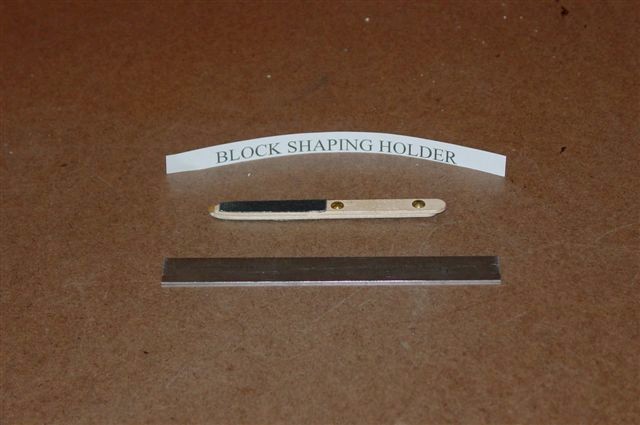
Block Shaping Holder directions:
"Take
two ice cream sticks. (my research reveals that they are usually
made of beech or birch). They are generally 3/32" thick
by 3/8" wide by 4 1/2" long, with a full radius on each
end.
Since they were going to handled , I gently sanded all the edges to form a smooth
surface all around.
Next, I clamped them together, having selected two sticks as close to each other
as possible in dimension. There are always variations and manufacturing
tolerances involved. I clamped them to form one double stick which became a piece
3/16" thick by 3/8" by 4 1/2" long.
I then measured from one end, which will be considered for our purposes as the
reference end.You can mark it if you wish.
I drilled two holes through the doubled up stick.The holes are 1/8" diameter.
They are located central to the 3/8" dimension or 3/16" from one side,
and 1/2" from the reference end. The second hole is 1 and 1/2" center
to center from the first hole.
Then , I made a flat at the end opposite the reference end 3/16" wide. I
drilled a small hole into the end of one stick, hereafter to be known as the
block mounting stick.
The size of the hole is determined by the hole in the block(s) you will be shaping.
In my case, the hole was .0225" of an inch. Or a # 74 drill.
Now, you will need to press a pin into the hole. A good source for
pins is to cut off the length needed from the shank end of a twist drill.
They are available from places like Micro Mark, etc. (I have no commercial interest
).
You can use carbon steel drills that are much less in cost than high speed steel,
and ideal for our purpose.
After you the press the pin into the end of the block mounting stick, it should
protrude about 1/8",again, determined by the size of your block.
The pin has to stick out and be a little longer than the width of the block to
secure it and for ease of insertion. Then, I made two brass hollow
rivets. They are going to be pressed together at assembly to contain
the sticks.
Before, assembly, I slotted or elongated the hole in the clamp stick (the stick
without the mounting pin) to 1/4" long, towards the reference end. This
provides, when assembled with the rivets, a travel of 1/8"
I then cemented to each stick a piece of thin flat rubber with a grip surface
3/8" wide by 2" long. At the end opposite the reference
end. This allows you to move the clamp stick up and down easier.
Now, put the sticks together, press the hollow rivets into each other allowing
the sticks to move easily, but without too much free play. In use,
the first shaping session will cause the clamping stick to arrive at it's final
shape.
OK, here we go.
Hold the tool upright with the reference end down, and the pin pointing toward
the heavens. Between thumb and forefinger, left or right, because
this is a ambidextrous tool, pull the clamp stick down, exposing the mounting
pin
Now, place a block onto the pin. It should be a firm push fit. No shake.
With the thumb, push up so the clamp stick contains the block . You
have now created a No Fly Zone, which is the main reason I developed, designed,
and fabricated this tool. I really do not like crawling around
on my hands and knees, looking for miniscule parts.
Take a good needle file and shape the block. The first time, you will be cutting
the clamp stick as well. After you like the first side, retract the
clamp stick, take the block off the pin, turn it over, and put the block on the
pin with the second side up.
Push up the clamp stick.
Shape the second side.
Retract the clamp stick, remove the block and you are ready for the next block,
and the next block , etc ad infinitum......
One important tip, to try to cut down on the loss of blocks, which can occur
unless they are in the No Fly Zone, try rolling the block between your thumb
and finger, and place it into a suitable container. I say suitable,
because if the container is not screwed to the workbench, Murphy's Law states
that the container, and all the blocks and your hard work, will be scattered
to the four winds.
If you want to cheat, and not use, or can't make hollow rivets, I offer the following
solution. You can bolt them together with screws, and washers, (on
the nut side) and nuts. After you have the movement the way you want
it, put a drop of CA into the nut.
Another alternative, make friends with your local machinist. :)
However that is not in keeping with the highest tradition of the Jerry Glickstein's
School of Toolmaking."